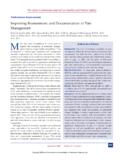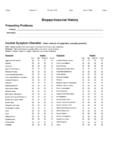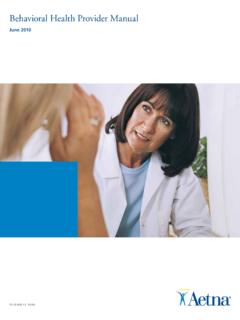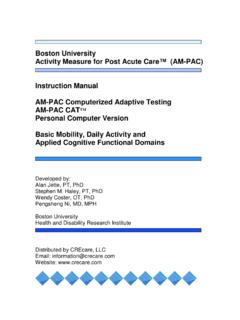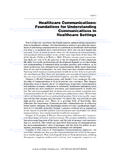Transcription of Improving Reassessment and Documentation of …
1 The Joint Commission Journal on Quality and Patient Safety Performance Improvement Improving Reassessment and Documentation of Pain Management Debra B. Gordon, , ; Susan M. Rees, , , ; Maureen P. McCausland, , ;. Teresa A. Pellino, , ; Sue Sanford-Ring, ; Jackie Smith-Helmenstine, ; Dianne M. Danis, , M. uch has been accomplished in recent years to Article-at-a-Glance improve the recognition of inadequate manage- ment of pain as a major health care 4 The Background: The Joint Commission standards on pain development of national pain assessment and management management address the Documentation of assessment and standards implemented by The Joint Commission in 2001 Reassessment .
2 Yet, little has been published to describe exerted a major impact across health care settings in the United when and how nurses perform and communicate reassess- The standards require accredited health care facilities to ment of pain. In 2005, the University of Wisconsin recognize the right of patients to appropriate assessment and Hospital & Clinics (UWHC) was inconsistently reassessing management of pain (Standard ); to assess pain in all pain after interventions, and documented reassessments patients (Standard ); to record the assessment in a way were primarily confined to pain-intensity ratings.
3 That facilitates regular Reassessment and follow-up; to educate Plan-Do-Check-Act: A large-scale plan-do-check-act patients , families, and providers (Standard ); to estab- (PDCA) cycle was implemented to improve the documen- lish policies that support appropriate prescription or ordering tation of pain reassessments, including development of an of (pain) medicines (Standard ); and to collect data to evidence-based administrative policy, repetitive education monitor the appropriateness and effectiveness of pain manage- efforts with bedside coaching, changes in daily bedside doc- ment (Standard ).
4 6 umentation flow sheets, and audit and feedback. Implementation of the standards has not been without chal- Results: From May 29, 2006, through July 16, 2008, a Regrettably, the call to improve pain management has cumulative rate of appropriately documented pain led in some situations to overtreatment and reported increases reassessments was achieved. in the incidence of critical ,8,9 For example, the Institute Discussion: Despite implementation of an evidence-based for Safe Medication Practices (ISMP) noted that overaggressive policy to clarify requirements for pain Reassessment , repeti- pain management led to alarming increases in oversedation and tive educational efforts, changes in daily bedside flow sheets, fatal respiratory depression From January 1995 direct and extensive leadership involvement in the form of through June 2006, 20% of 369 medication error related sen- continuous bedside coaching.
5 Combined with more timely tinel events (the category with the largest number of sentinel and persistent audit and feedback and clear accountability events) in the Joint Commission database involved and alignment with goals, was necessary for substantial Ninety-eight percent of the opioid-related events resulted in change. Strategies to sustain improvements include daily patient death. Thus, it is critical that as pain treatment becomes administrative and monthly staff Documentation audits more aggressive, so too does our attention to Reassessment of with prompt feedback to clinical nurse managers and staff.
6 Pain after intervention to ensure both safe and effective pain Nurses are instructed on the importance of pain reassess- management. ments and on the policy and specific Documentation re- Although the Joint Commission standards have influenced quirements. Reassessment of pain is a routine variable many organizations to successfully implement policies and displayed on unit and departmental quality dashboards. practices to ensure routine screening and assessment of pain, Further study should examine if the intensity of this require- little has been published to describe when and how nurses per- ment for pain Reassessment Documentation ultimately facil- form and communicate Reassessment of pain.
7 This article itates the safety and effectiveness of pain management. describe one hospital's experiences in Improving performance September 2008 Volume 34 Number 9 509. Copyright 2008 Joint Commission on Accreditation of Healthcare Organizations The Joint Commission Journal on Quality and Patient Safety and Documentation of pain reassessments after a significant Average Number of Documented practice deficit was uncovered during a Joint Commission Numeric Pain Ratings, 1994 2007. accreditation survey in 2005, resulting in a Requirement for Improvement (RFI).
8 A plan-do-check-act (PDCA) framework is used to describe inconsistencies found in practice, strategies that led to improvement, and lessons learned. Methods PAIN MANAGEMENT QUALITY IMPROVEMENT TEAM. The University of Wisconsin Hospital & Clinics (UWHC) is a 472-bed tertiary care medical center, a Level 1 trauma center, and a National Cancer Institute (NCI) designated compre- hensive cancer center. Figure 1. The average number of documented pain-intensity ratings per 24. In 1991, UWHC formed an interdisciplinary pain manage- hours on individual patients , based on monthly Documentation audit data, ment quality improvement (QI) team to improve pain manage- are shown.
9 Each month, all inpatient units (adult and pediatric) complete an audit of nursing Documentation using a sample size representative of the unit's ment through education, the development of processes and average daily census. This provides a total inpatient adult sample size of 310. programs intended to improve clinical practice, and outcome to 430 audits per month from which the graphed average is derived. monitoring. The team, co-led by a pain management clinical nurse specialist [ ] and physician, is composed of approx- imately 50 staff from across the organization, including nurses, more comprehensive explanation of intervention activities and pharmacists, physicians, social workers, psychologists, and patient response other than pain-intensity ratings, sedation other staff from both inpatient and outpatient settings.
10 Scores, and vital signs. In response to this finding, a task force was formed with staff PLAN nurses from three councils (nursing practice, nursing research In October 2005, during individual Joint Commission and the unit council chairs) to implement a focused QI cycle. tracer activity at UWHC, it was noted that Reassessment of pain An evidence-based process was initiated to define practice after interventions was not done consistently. Despite the pres- expectations related to pain reassessments. Relevant literature ence of numerous documented pain-intensity ratings in med- was gathered and critiqued.
